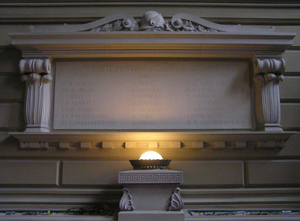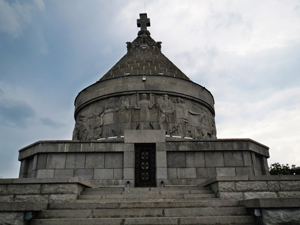When commemorating 100 years since the end of World War One by signing the Armistice of Compiègne on the morning of 11 November 1918, it is our duty to honour the memory of those who, through their sacrifice, made the Great Union possible.

White stone plaque dedicated to the NBR employees
who fell in the line of duty in World War One,
NBR Palace in Lipscani Street
Among them are 201 employees of the Nation Bank of Romania who fought in World War One, 21 of whom losing their lives for our country: Ioan I. Slăvescu, Constantin Biciola, Constantin Colac (Secretariat Department), Ștefan G. Ioanin (Accounting Division), Dumitru N. Vasiliu, Ștefan Constantinescu, Ioan Dumitrescu (Discount Department), Gheorghe Gh. Dumitrescu (Deposits Division), Ioan E. Vergatti (General Audit Department), Matei Oproiu (Notes Division), Constantin Georgescu, Ioan Pătulea, Grigore Săndulescu (Printing Works), Haralambie Popa (Galați Branch), Dumitru P. Constantinescu, Constantin Enescu (Constanța Agency), Marin N. Ionescu (Focșani Agency), Alexandru I. Popescu, Mihalache Ionescu (Ploiești Agency), Ioan Crivăț (Târgu Jiu Agency), Petre Popa.
The remains of most of them were buried alongside those of the other heroes of the country in the Mausoleum of Mărășești built through the efforts of the National Orthodox Society of Romanian Women and with the support of the National Bank of Romania.
Information about the heroes who were employees of the issuing house is scarce. Few documents were kept in the Bank’s archives, some accounts were given by their families. That is how we could find out more about the ultimate sacrifice of some of them, yet it is much too little compared to what we would have liked to know.

The Mausoleum of Mărășești
Ioan I. Slăvescu, from the Secretariat Department, second lieutenant of the 18th Regiment Gorj, died on 11 September 1916, at Buliga pass, firing a machine gun seized by his platoon, fighting off two companies and a Bavarian machine gun section. All of Ioan Slăvescu’s seven brothers fought on the frontlines, although the law allowed for four of them to remain behind the lines. Three of them passed away on the battlefield.
Ștefan G. Ioanin, from the Accounting Division, second lieutenant of the 9th Regiment Roșiori, died in Onești, while leading a squad, after the captain, lieutenant and another second lieutenant all had taken charge in turn, falling one by one.
Haralambie Popa, accountant at the Galați Branch, lieutenant of the 11th Regiment Siret, perished on 13 December 1916, in the vicinity of Râmnicu Sărat. After being wounded, while two stretcher-bearers were bandaging him on the battlefield, they were hit by an enemy projectile and all three were buried alive.
Ștefan Constantinescu, from the Discount Division, was a second lieutenant of the 78th Regiment Brăila. On 31 August 1916, he was badly injured in Dobrudja. After making his recovery, he asked to be sent back to the frontlines, although he had been advised to take an administrative position in the army. He lost his life in combat in the summer of 1917, close to Adjud. He was promoted to the rank of captain posthumously.

The Constantinescu brothers in 1915: Mircea, Virgil – standing;
Gheorghe, Ștefan (NBR employee), Nicolae – seated;
source: www.europeana1914-1918.eu
As luck would have it, the latter’s thoughts stood the test of time, written down in pencil on the pages of a tactical notebook. Ștefan Constantinescu’s notes, made available to the public by his nephew, Professor Nicolae Constantinescu, MD, a renowned surgeon, cover the period between 14 and 20 October 1916 and retrace the initiation journey undertaken by the young clerk to become the army officer who did not hesitate to fight on the frontlines until his very last breath. We will not dwell upon these notes, as those interested can find them at Europeana Collections, but we will render below a few passages illustrating the intensity of the feelings of a young Romanian second lieutenant, who had been an NBR employee in his day-to-day life.
“When I first saw our troops retreating,” wrote Ștefan Constantinescu, “In my heart, I was quick to blame of being cowards those who were retreating […]. My mind could not imagine such a thing. I thought that if the whole army were to flee, our regiment, or our battalion, or at least my company would hold off and save the day…
At around five o’clock in the evening, they broke the lines on one of the wings. We were overtaken. Any attempt to resist was futile. Our troops retreated before the deluge of soldiers, eight of them to one of ours, in addition to their German weaponry to which we could not compare. Thus, I had the woeful privilege to find an explanation for all our troops’ retreats, which I had accused of cowardice. Those who retreated were not cowards, after trying to hold off, step by step, the invading flood […]. Yet it was not humanly possible to do more than we had done under such circumstances”.
To honour the memory of those who had done all that was humanly possible, on 11 November 1937, on Armistice Day, a commemorative plaque made of white stone was unveiled at the National Bank of Romania, after a draft drawn up by the architect Radu Dudescu. The plaque was placed in the Palace in Lipscani Street, on the main floor of the honour staircase. The ceremony was attended by the Bank’s executives, many clerks and pensioners, and the relatives of those who died in battle.
Now, 100 years since the Great Union, by remembering the hero employees of the National Bank who fell on the frontlines, we try, as noted in the NBR Board Report of February 1938, to fulfil “[…] a great and pious duty to those who served the Institution with zeal and devotion and defended their Motherland with ardour and made the ultimate sacrifice. May their memory be forever alive, honoured and a bright example for all of us!”